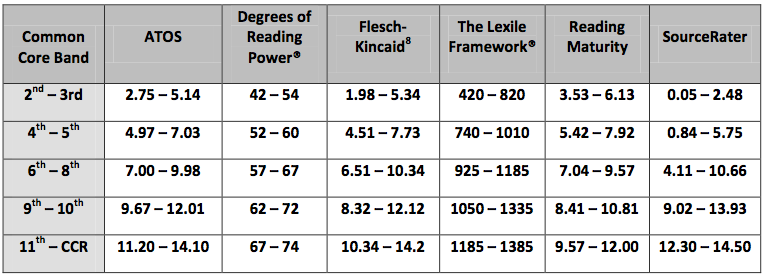Core Tech for Learning with ELA Common Core #ISTE2014
In this post, I will share some of what I learned from them, and add in a few more resources, ideas, and tools.
ELA Text Complexity
Readability levels are an important ingredient for figuring out text complexity. Reading Standard 10 specifically states that students must read complex text, "Read and comprehend complex literary and informational texts independently and proficiently."
Text complexity reminds me of a s'more. It contains three main parts, and while you can talk about each ingredient separately, it's not really a s'more until you put them all together.
Tools for readability
Have you ever wondered if the text on a website is the appropriate reading level for your students? Here are some tools for assessing the quantitative measures of readability:
- Online-Utility.org: Determines the Flesh-Kincade Reading Level by copying and pasting the text into the box.
- Lexile Analyzer: You can scan your text (or type it in) to see the complexity of what you've written (or text in any website). Note, you'll have to register to use this site.
- ATOS: Determines the ATOS reading level by copying and pasting the text into the box.
- Lexile: This site helps you find the lexile range, and recommended books for that range.
 |
| Table: Supplemental Information for Appendix A of the Common Core State Standards |
Writing readability and editor
Sure, you can use the tools mentioned above to assess the readability of a student's writing, but the following tool also includes editing.
- Hemingway app: This tool color codes sentences with editing suggestions for lengthy sentences, passive voice, etc. Note: This app currently costs $4.99.
Text with adjustable readability
- Google advanced search: Set the readability levels in the advanced search.
- ReadWorks: Reading passages, lessons, and units with comprehension questions for K-8th and by select domain or standard.
- Newsela: You can find current events by content area. Create student accounts and it will provide different copies of an article with various reading levels.
 |
| Here's an example of the Newsela teacher dashboard |
Online books
- Project Gutenberg: Free ebooks that are available for free download (in the USA). They can be read online or through the Kindle App. (The Kindle App is a free app, and it allows you to read texts in a variety of formats on a variety of devices -- not just on a Kindle. You can highlight and annotate with this app, and the selections can be saved using a student's free account at Amazon.)
- Oxford Owl: Free ebooks that are tablet friendly.
- Google books: This is a great research tool for online books. I recommend looking at this tutorial on Free Tech for Teachers by Richard Byrne.
- Open Library: Borrow and read books.
- Bookshare: An accessible online library of books with large print, great for people with print disabilities.
- Metropolitan Museum of Art and Getty Publications: Read, download, or search online art history books for free.
Online portfolios
There are many tools that can be used as a portfolio. The beauty of a portfolio is it shows growth over time.
Have you considered these tools for portfolios?
- Edublogs, Wordpress, Blogger, or Kidblog: Blogging allows writers to connect with an audience beyond the four classroom walls.
- WeVideo or YouTube: Vlogging (video blogging) again allows authors to connect with a global audience. Both of these have built in video editing tools.
- Evernote: This tool is great for note taking, keeping documents organized, and annotating documents. Other tools that work with Evernote are: Skitch, Penultimate, Web Clipper, Peek, etc.
- Flickr: Photography portfolios allow students to create personal history museums, collecting photographs of artifacts and sharing the importance of those artifacts. (A special thanks to Denise Krebs for this idea.)
There are many resources available for learning the ELA standards. Technology is included in those standards. We are no longer in a day and age of putting technology off as something we didn't get to. Technology is essential for students to be prepared for college and careers, and it is built into today's learning standards.
- What ELA tools and resources would you add to this list?
- What other thoughts or ideas from this post would you like to challenge, add to, or share?





Hi Tracy,
ReplyDeleteAs always, you have provided a meaty post! Thanks for sharing all these great resources. Thanks, too, for linking to Shiann's history portfolio. I think she has some touching items in her "personal history museum."
Flickr can be used for so much more, too--any subject, probably. We also created a set of book spine poems and here is one of our life science portfolios, made when we walked to a local nature trail.
Of course, you didn't talk about productivity tools, but I just have to mention one. I don't think I could teach ELA any longer without Google Drive and all the sharing and editing features. I just wrote a blog post today about how Google Forms makes reading students' blog posts so much more efficient!
Thanks again,
Denise
Thanks Denise!
DeleteYour post has fabulous ideas. I appreciate how you linked to student examples and included step-by-step instructions for how to collect URLs through Google Forms for managing online assignments. Fabulous!
Kind regards,
Tracy